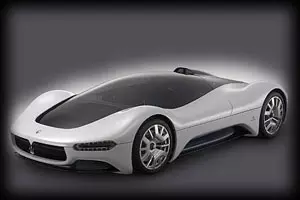It is the fruit of the joint work between Maserati, Pininfarina and Motorola. The concept integrates the vision of the three companies: sports heritage, exclusive design and high technological development.
 Working together as in the past, when they faced the development of the Quattroporte, Pininfarina and Maserati on this occasion celebrate for a special reason such as the 75th anniversary of Pininfarina.
Working together as in the past, when they faced the development of the Quattroporte, Pininfarina and Maserati on this occasion celebrate for a special reason such as the 75th anniversary of Pininfarina.
They sought to express their joy through a concept that evokes the mythical European competition prototypes of the 50s and 60s. At that time, racing prototypes reached a remarkable level of excellence in both exterior design and applied technology. Although it should be mentioned that current environmental regulations are not as permissive as in those days...
The name Birdcage is not new, it is actually the nickname that the Type 63 received for its chassis of tubes that are well visible through a huge transparent windshield. That Type 63 had a front engine V12 of 3.000 cm3 of displacement that delivered 320 HP at 8,200 RPM. In 1961 he achieved good results at LeMans and won the Bridgehampton races and the 500 miles of Elkhart Lake in the USA.
Based on the Maserati MC12's competitive chassis, the Birdcage 75th is an attempt to achieve unusual sensuality and a maximum degree of purity in every body detail. A real sculpture. To harmonize between exterior and interior, they were designed with a very appropriate unity criterion. This allows, despite being very traditional, not to detain the interior from the outside. They were conceived as a single object.
Of course it all started with the development of the chassis and the engine, which would then be integrated by the body so meticulously designed to merge the mechanical with the formal. What we can call hard and soft.
As is already known in the competition environments, the most effective aerodynamically is an inverted wing body with a bulging droplet or teardrop cabin, with the larger section at the front and the reduction towards the tail.
It is vital to ensure that the air flows smoothly both above and below the car, channeled in such a way that due to pressure difference the desired adhesion is achieved which provides stability at high speeds. For this purpose it also has active diffusion systems in the tail of the body. So the Birdcage 75th was born, that was his design premise. Aerodynamically efficient shapes combined with smooth lines and distinctive features.
A car that evokes racing prototypes that made history “must” have features similar to that heritage. The V12 engine has 48 valves (DOHC) and exceeds 700 horsepower it transmits to the rear wheels through a semi-automatic 6-speed gearbox.
The front wheels are 20 inches and the rear wheels are 22 inches. The design of the rims recreates the Maserati Trident logo and, like the racing ones, they fit with a single center nut.
The carbon fiber chassis can be appreciated through the vast glazed surface of the vehicle. It also allows high visibility for the driver and an interesting effect that integrates colours and ergonomic sensations.
Ergonomics involves our senses with the objects with which we interact. For example, the fact of having a large, continuous and uninterrupted glazed surface that allows us to see a dark interior, contrasting with a white body that only reaches the waist of the car makes us perceive the vehicle even lower in height than it already is.
Other features to mention are the latest technology front and rear lights. Developed in conjunction with OSRAM Opto Semiconductors, they use state-of-the-art LEDs housed in special ceiling lights machined from aluminum blocks. What makes them so special is their design to efficiently dissipate the generated heat.
The interior combines technologically advanced materials, such as carbon fiber, with more elegant and traditional ones. And for the merger to be complete, the third component of the development comes with its contribution: Motorola, with a great deployment of onboard technology.
© Adrián Blanco 2005 — Prohibited the total or partial reproduction of text and/or images without explicit written consent of the author. —
 The 50 fastest accelerating The 50 fastest in the world The Porsche sedan VW Concept C VW Concept R Viper SRT 10 Coupe 2006 Dodge Magnum SRT8 2006 at Corvette C6-R Nissan 350 Z BMW M6 Mercedes CLS
The 50 fastest accelerating The 50 fastest in the world The Porsche sedan VW Concept C VW Concept R Viper SRT 10 Coupe 2006 Dodge Magnum SRT8 2006 at Corvette C6-R Nissan 350 Z BMW M6 Mercedes CLS